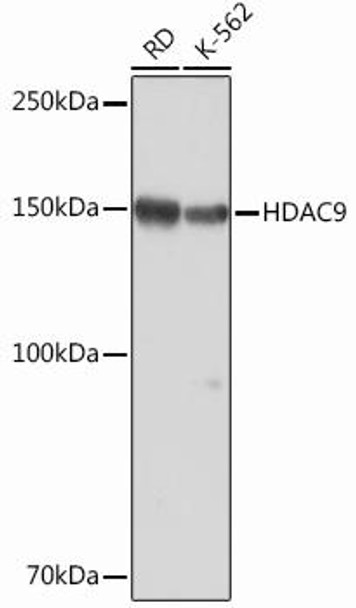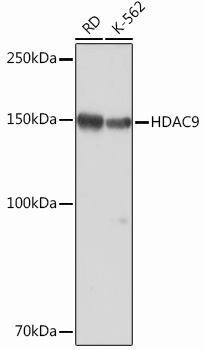Anti-HDAC9 Antibody (CAB2226)
- SKU:
- CAB2226
- Product type:
- Antibody
- Reactivity:
- Human
- Reactivity:
- Rat
- Host Species:
- Rabbit
- Isotype:
- IgG
- Research Area:
- Epigenetics and Nuclear Signaling
Description
| 抗体名: | Anti-HDAC9 Antibody |
| 抗体コード: | CAB2226 |
| 抗体サイズ: | 20uL, 50uL, 100uL |
| 申し込み: | WB IHC IF |
| 反応性: | Human, Rat |
| 宿主種: | Rabbit |
| 免疫原: | A synthesized peptide derived from human HDAC9 |
| 申し込み: | WB IHC IF |
| 推奨希釈: | WB 1:500 - 1:2000 IHC 1:50 - 1:200 IF 1:50 - 1:200 |
| 反応性: | Human, Rat |
| ポジティブサンプル: | RD, K-562 |
| 免疫原: | A synthesized peptide derived from human HDAC9 |
| 精製方法: | Affinity purification |
| ストレージバッファ: | Store at -20'C. Avoid freeze / thaw cycles. Buffer: PBS with 0.02% sodium azide, 0.05% BSA, 50% glycerol, pH7.3. |
| アイソタイプ: | IgG |
| 順序: | Email for sequence |
| 遺伝子ID: | 9734 |
| Uniprot: | Q9UKV0 |
| セルラーロケーション: | |
| 計算された分子量: | 160kDa |
| 観察された分子量: | 150KDa |
| 同義語: | HD7, HD7b, HD9, HDAC, HDAC7, HDAC7B, HDAC9B, HDAC9FL, HDRP, MITR |
| バックグラウンド: | Histones play a critical role in transcriptional regulation, cell cycle progression, and developmental events. Histone acetylation/deacetylation alters chromosome structure and affects transcription factor access to DNA. The protein encoded by this gene has sequence homology to members of the histone deacetylase family. This gene is orthologous to the Xenopus and mouse MITR genes. The MITR protein lacks the histone deacetylase catalytic domain. It represses MEF2 activity through recruitment of multicomponent corepressor complexes that include CtBP and HDACs. This encoded protein may play a role in hematopoiesis. Multiple alternatively spliced transcripts have been described for this gene but the full-length nature of some of them has not been determined. [provided by RefSeq, Jul 2008] |
| UniProt Protein Function: | HDAC9: a transcriptional regulator of the histone deacetylase family, subfamily 2. Deacetylates lysine residues on the N-terminal part of the core histones H2A, H2B, H3 AND H4. Plays an important role in transcriptional regulation, cell cycle progression and developmental events. Histone deacetylases act via the formation of large multiprotein complexes. |
| UniProt Protein Details: | Protein type:Deacetylase; EC 3.5.1.98; Transcription, coactivator/corepressor Chromosomal Location of Human Ortholog: 7p21.1 Cellular Component: nucleoplasm; histone methyltransferase complex; transcription factor complex; cytoplasm; histone deacetylase complex; nucleus Molecular Function:NAD-dependent histone deacetylase activity (H3-K9 specific); protein binding; protein kinase C binding; NAD-dependent histone deacetylase activity (H3-K14 specific); metal ion binding; histone deacetylase binding; protein deacetylase activity; NAD-dependent histone deacetylase activity (H4-K16 specific); histone deacetylase activity; transcription corepressor activity; transcription factor binding Biological Process: regulation of skeletal muscle fiber development; Notch signaling pathway; B cell activation; cellular response to insulin stimulus; transcription, DNA-dependent; regulation of striated muscle cell differentiation; B cell differentiation; heart development; histone deacetylation; negative regulation of transcription from RNA polymerase II promoter; inflammatory response; negative regulation of transcription, DNA-dependent |
| NCBI Summary: | Histones play a critical role in transcriptional regulation, cell cycle progression, and developmental events. Histone acetylation/deacetylation alters chromosome structure and affects transcription factor access to DNA. The protein encoded by this gene has sequence homology to members of the histone deacetylase family. This gene is orthologous to the Xenopus and mouse MITR genes. The MITR protein lacks the histone deacetylase catalytic domain. It represses MEF2 activity through recruitment of multicomponent corepressor complexes that include CtBP and HDACs. This encoded protein may play a role in hematopoiesis. Multiple alternatively spliced transcripts have been described for this gene but the full-length nature of some of them has not been determined. [provided by RefSeq, Jul 2008] |
| UniProt Code: | Q9UKV0 |
| NCBI GenInfo Identifier: | 19865267 |
| NCBI Gene ID: | 9734 |
| NCBI Accession: | Q9UKV0.2 |
| UniProt Secondary Accession: | Q9UKV0,O94845, O95028, Q2M2R6, A7E2F3, B7Z4I4, B7Z917 B7Z928, B7Z940, C9JS87, E7EX34, F8W9E0, |
| UniProt Related Accession: | Q9UKV0 |
| Molecular Weight: | 1011 |
| NCBI Full Name: | Histone deacetylase 9 |
| NCBI Synonym Full Names: | histone deacetylase 9 |
| NCBI Official Symbol: | HDAC9 |
| NCBI Official Synonym Symbols: | HD7; HD9; HD7b; HDAC; HDRP; MITR; HDAC7; HDAC7B; HDAC9B; HDAC9FL |
| NCBI Protein Information: | histone deacetylase 9; histone deacetylase 7B; histone deacetylase 4/5-related protein; MEF-2 interacting transcription repressor (MITR) protein |
| UniProt Protein Name: | Histone deacetylase 9 |
| UniProt Synonym Protein Names: | Histone deacetylase 7B; HD7; HD7b; Histone deacetylase-related protein; MEF2-interacting transcription repressor MITR |
| UniProt Gene Name: | HDAC9 |
| UniProt Entry Name: | HDAC9_HUMAN |


